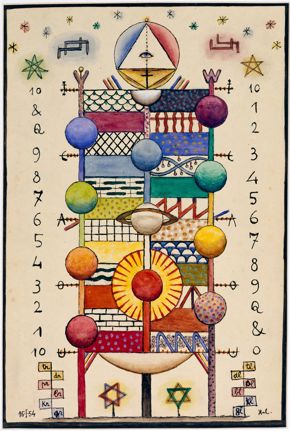Happy Birthday, Xul Solar: A Closer Look at the Argentinean Artist’s Work December 14, 2018

Alejandro Xul Solar, Pan-Tree, 1954, watercolor and ink on paper board, the Museum of Fine Arts, Houston, gift of Fundación Pan Klub, Museo Xul Solar, Buenos Aires. © Fundación Pan Klub Museo Xul Solar
Xul Solar, Jefa (Patroness), 1923, watercolor on paper, set on cardboard. © Fundación Pan Klub - Museo Xul Solar
December 14 marks the 131st birthday of Xul Solar, an Argentinean painter, poet, and inventor. The anniversary of his birth offers an opportunity to take a closer look at his intriguing work based on his study of music, astrology, complex theories of language and writing, and the spiritual beliefs of numerous world religions.
Born Alejandro Schulz Solari (1887−1963), he changed his name to Xul Solar—an approximate anagram of “lux solaris,” from the Latin for “light of the sun.” He first studied architecture in 1906 before turning to music. His intellectual pursuits were constantly fueled by theater, philosophy, and the history of art. In addition to these personal studies, Xul’s close friendship with author Jorge Luis Borges was highly influential to Xul’s work.
Xul’s search for higher knowledge, for the unrevealed truth, guided him throughout his life and led him to approach different religions and forms of belief in his artwork. From the beginning, the artist desired to “found a new religion on my art and create a world for my followers,” as he wrote in his personal journal in 1912. This new world led the artist to create his own language: Neo-Creole. A fusion of Portuguese and Spanish, Neo-Creole also incorporated English, French, German, Greek, Latin, and Sanskrit roots. A new writing system accompanied the language, which he deemed as magical and perfect.
Xul chose Neo-Creole to communicate in his daily life, and he was driven increasingly by astrology and other occult traditions. His 1954 watercolor Pan-Tree can be seen as the culmination of these investigations as the mystical tree represents God and the universe. The artist ingeniously combines astrology with the Kabbalah, Jewish mystical tradition, producing a confluence between the 12 zodiac signs and the 22 letters of the Hebrew alphabet. Solar died in Buenos Aires in 1963.





